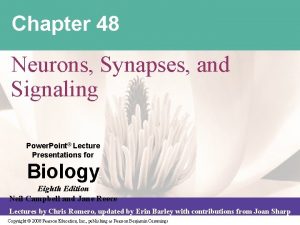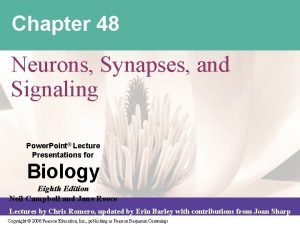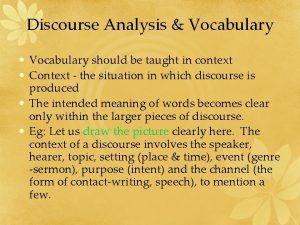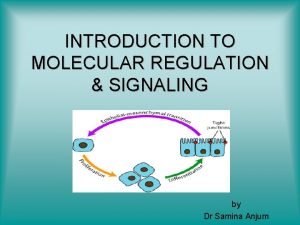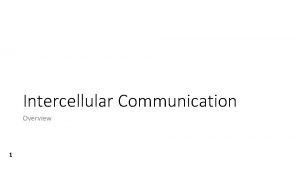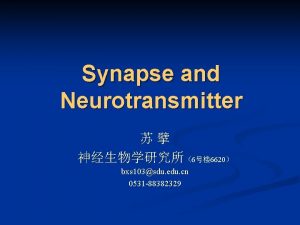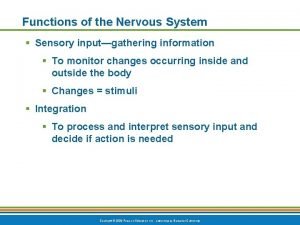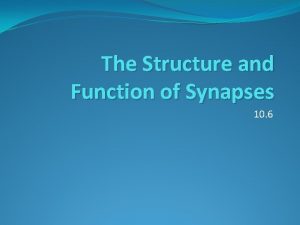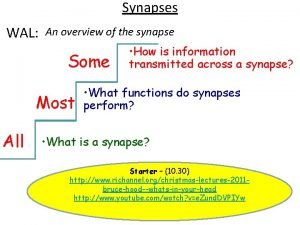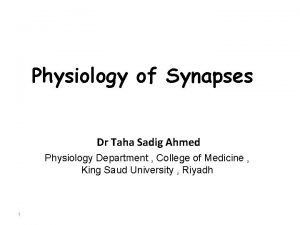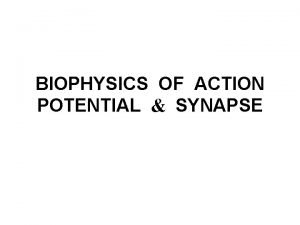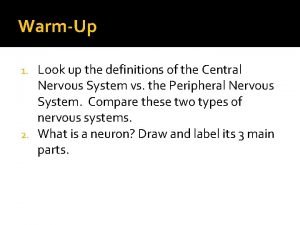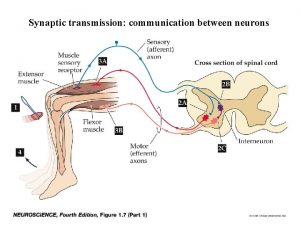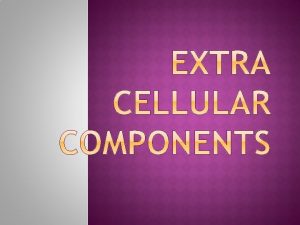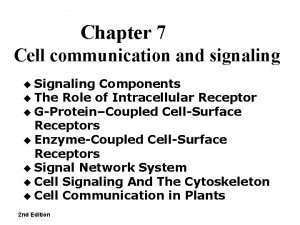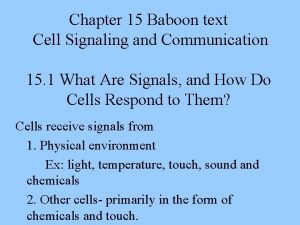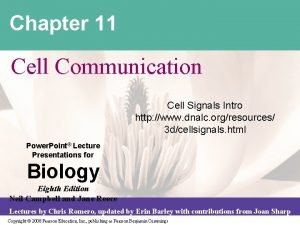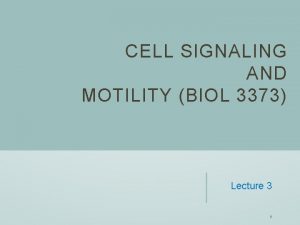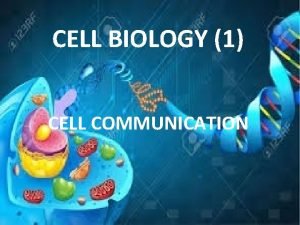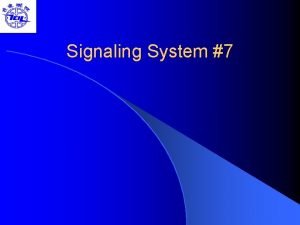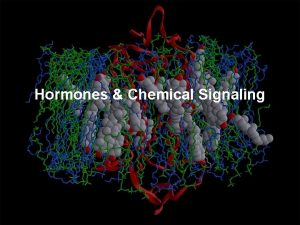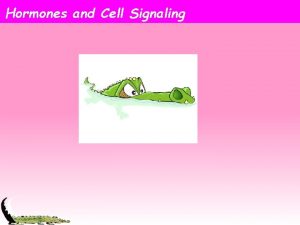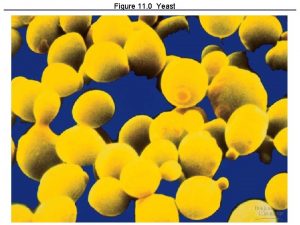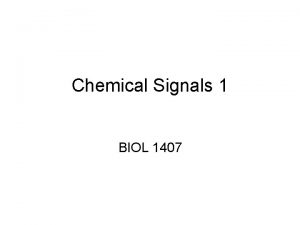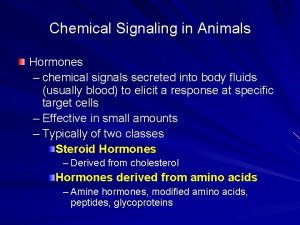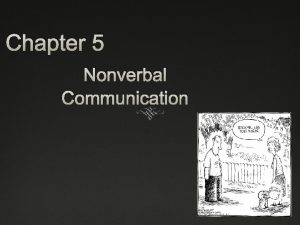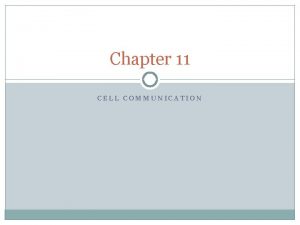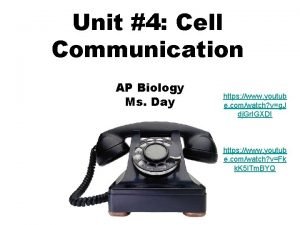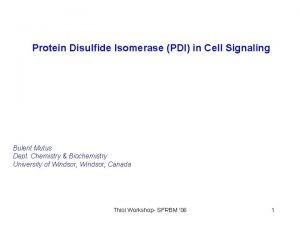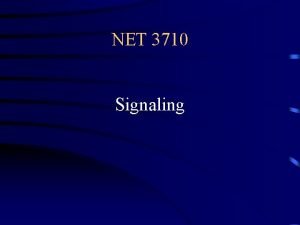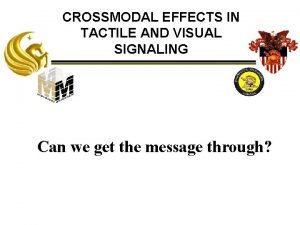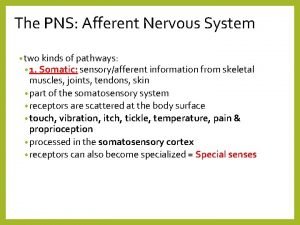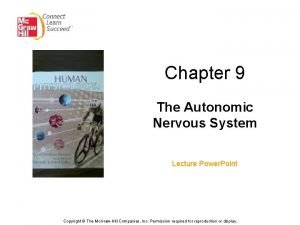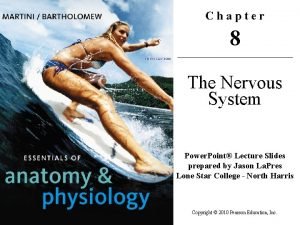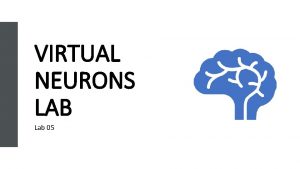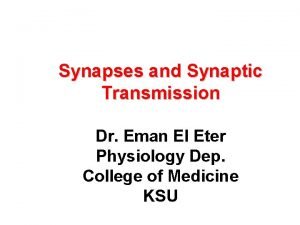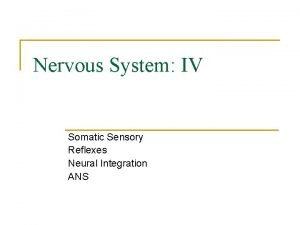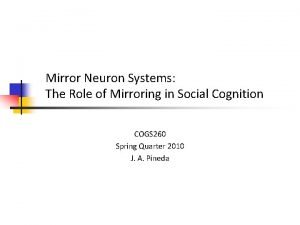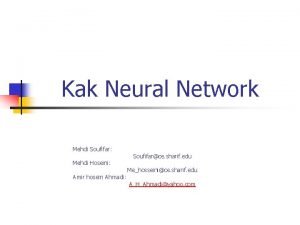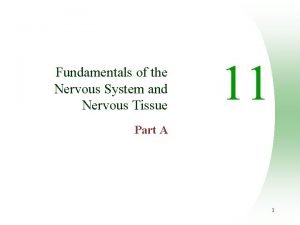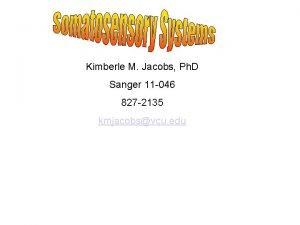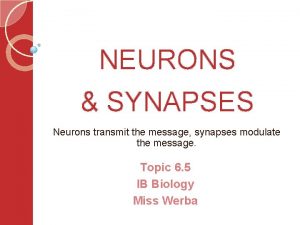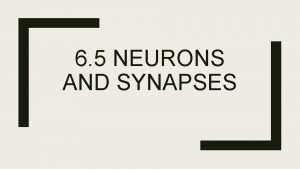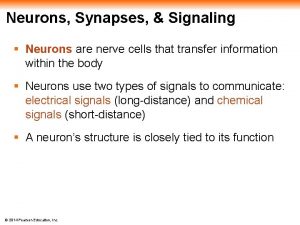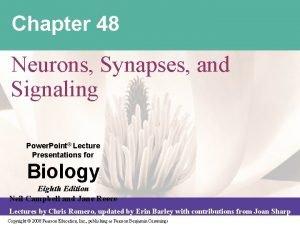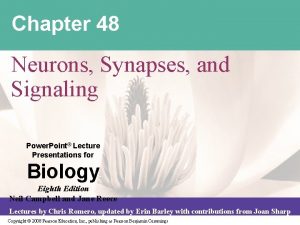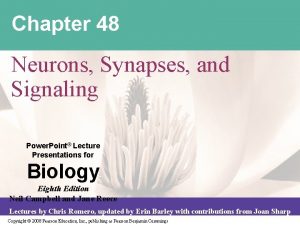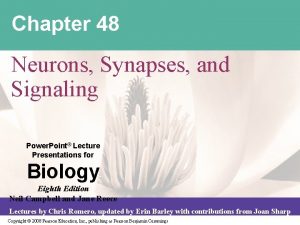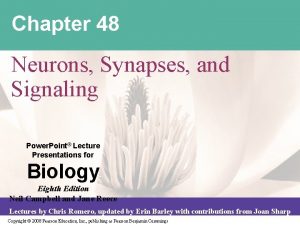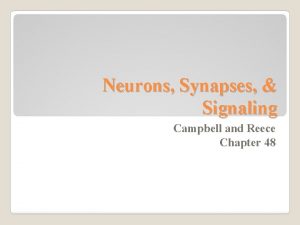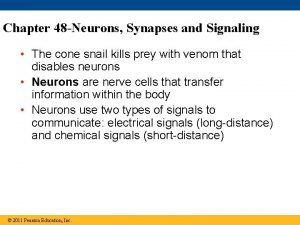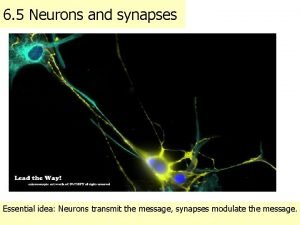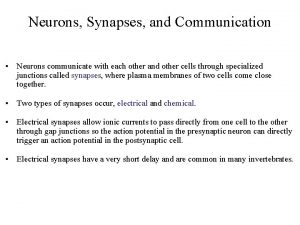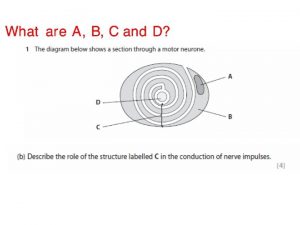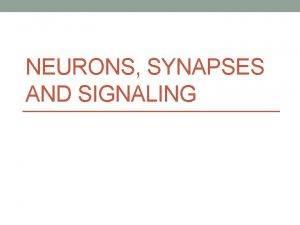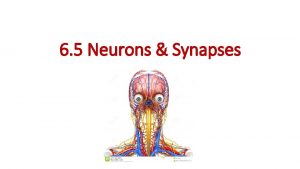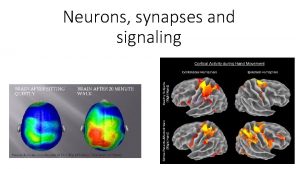Chapter 48 Neurons Synapses and Signaling Power Point














![Fig. 48 -6 Key Na+ K+ OUTSIDE CELL OUTSIDE [K+] CELL 5 m. M Fig. 48 -6 Key Na+ K+ OUTSIDE CELL OUTSIDE [K+] CELL 5 m. M](https://slidetodoc.com/presentation_image/40d30453c6ab8144f80eca28175815ee/image-15.jpg)








































- Slides: 55

Chapter 48 Neurons, Synapses, and Signaling Power. Point® Lecture Presentations for Biology Eighth Edition Neil Campbell and Jane Reece Lectures by Chris Romero, updated by Erin Barley with contributions from Joan Sharp Copyright © 2008 Pearson Education, Inc. , publishing as Pearson Benjamin Cummings

Overview: Lines of Communication • Cone snail kills prey with venom that disables neurons • Neurons are nerve cells that transfer information within the body • Two types of signals to communicate: electrical (long-distance) chemical (short-distance) Copyright © 2008 Pearson Education, Inc. , publishing as Pearson Benjamin Cummings

• The transmission of information depends on the path of neurons along which a signal travels • Processing of information ü simple clusters of neurons called ganglia ü more complex organization of neurons called a brain Copyright © 2008 Pearson Education, Inc. , publishing as Pearson Benjamin Cummings

Concept 48. 1: Neuron organization and structure reflect function in information transfer • The squid possesses extremely large nerve cells and is a good model for studying neuron function Copyright © 2008 Pearson Education, Inc. , publishing as Pearson Benjamin Cummings

Introduction to Information Processing Nervous systems process three stages: sensory input, integration, and motor output 1) Sensors detect external stimuli and internal conditions and transmit information along sensory neurons 2) Sensory information is sent to the brain/ganglia, where interneurons integrate the information 3) Motor output leaves the brain or ganglia via motor neurons, which trigger muscle or gland activity Copyright © 2008 Pearson Education, Inc. , publishing as Pearson Benjamin Cummings

• Many animals have a complex nervous system which consists of: – A central nervous system (CNS) where integration takes place; this includes the brain and a nerve cord – A peripheral nervous system (PNS), which brings information into and out of the CNS Copyright © 2008 Pearson Education, Inc. , publishing as Pearson Benjamin Cummings

Fig. 48 -3 Sensory input Integration Sensor Motor output Effector Peripheral nervous system (PNS) Central nervous system (CNS)

Neuron Structure and Function • Most of a neuron’s organelles are in the cell body • Dendrites - highly branched extensions that receive signals from other neurons • Axon - a much longer extension that transmits signals to other cells at synapses (connection point between cells where information is passed in the form of chemical messengers called neurotransmitters) • An axon joins the cell body at the axon hillock Copyright © 2008 Pearson Education, Inc. , publishing as Pearson Benjamin Cummings

• Information is transmitted from a presynaptic cell (a neuron) to a postsynaptic cell (a neuron, muscle, or gland cell) • Most neurons are nourished or insulated by cells called glia Copyright © 2008 Pearson Education, Inc. , publishing as Pearson Benjamin Cummings

Fig. 48 -4 Dendrites Stimulus Nucleus Cell body Axon hillock Presynaptic cell Axon Synapse Synaptic terminals Postsynaptic cell Neurotransmitter

Fig. 48 -5 Form Fits Function Variation Dendrites Axon Cell body Portion of axon Sensory neuron Interneurons Cell bodies of overlapping neurons 80 µm Motor neuron

Ion pumps and ion channels maintain the resting potential of a neuron • Every cell has a voltage (difference in electrical charge) across its plasma membrane called a membrane potential • Messages are transmitted as changes in membrane potential • The resting potential is the membrane potential of a neuron not sending signals Copyright © 2008 Pearson Education, Inc. , publishing as Pearson Benjamin Cummings

Formation of the Resting Potential • In a mammalian neuron at resting potential, the concentration of K+ is greater inside the cell, while the concentration of Na+ is greater outside the cell (Overall Negative Internally) • Sodium-potassium pumps use the energy of ATP to maintain these K+ and Na+ gradients across the plasma membrane • These concentration gradients represent chemical potential energy Copyright © 2008 Pearson Education, Inc. , publishing as Pearson Benjamin Cummings

• The opening of ion channels in the plasma membrane converts chemical potential to electrical potential • A neuron at resting potential contains many open K+ channels and fewer open Na+ channels; K+ diffuses out of the cell • Anions trapped inside the cell contribute to the negative charge within the neuron Animation: Resting Potential Copyright © 2008 Pearson Education, Inc. , publishing as Pearson Benjamin Cummings
![Fig 48 6 Key Na K OUTSIDE CELL OUTSIDE K CELL 5 m M Fig. 48 -6 Key Na+ K+ OUTSIDE CELL OUTSIDE [K+] CELL 5 m. M](https://slidetodoc.com/presentation_image/40d30453c6ab8144f80eca28175815ee/image-15.jpg)
Fig. 48 -6 Key Na+ K+ OUTSIDE CELL OUTSIDE [K+] CELL 5 m. M INSIDE [K+] CELL 140 m. M [Na+] [Cl–] 150 m. M 120 m. M [Na+] 15 m. M [Cl–] 10 m. M [A–] 100 m. M INSIDE CELL (a) (b) Sodiumpotassium pump Potassium channel Sodium channel

Modeling of the Resting Potential • Resting potential can be modeled by an artificial membrane that separates two chambers – The concentration of KCl is higher in the inner chamber and lower in the outer chamber – K+ diffuses down its gradient to the outer chamber – Negative charge builds up in the inner chamber • At equilibrium, both the electrical and chemical gradients are balanced Copyright © 2008 Pearson Education, Inc. , publishing as Pearson Benjamin Cummings

Fig. 48 -7 – 90 m. V Inner chamber +62 m. V Outer chamber 140 m. M KCI 150 m. M 15 m. M Na. CI 5 m. M KCI Na. CI Cl– K+ Cl– Potassium channel (a) Membrane selectively permeable to K+ ( EK = 62 m. V log 5 m. M 140 m. M ) = – 90 m. V Na+ Sodium channel (b) Membrane selectively permeable to Na+ ENa = 62 m. V ( log 150 m. M 15 m. M ) = +62 m. V

• The equilibrium potential (Eion) is the membrane voltage for a particular ion at equilibrium and can be calculated using the Nernst equation: Eion = 62 m. V (log[ion]outside/[ion]inside) • The equilibrium potential of K+ (EK) is negative, while the equilibrium potential of Na+ (ENa) is positive Copyright © 2008 Pearson Education, Inc. , publishing as Pearson Benjamin Cummings

• In a resting neuron, the currents of K+ and Na+ are equal and opposite, and the resting potential across the membrane remains steady Copyright © 2008 Pearson Education, Inc. , publishing as Pearson Benjamin Cummings

Action potentials are the signals conducted by axons • Neurons contain gated ion channels that open or close in response to stimuli = membrane potential changes. • When gated K+ channels open, K+ diffuses out, making the inside of the cell more negative • Hyperpolarization, an increase in magnitude of the membrane potential Copyright © 2008 Pearson Education, Inc. , publishing as Pearson Benjamin Cummings

• Other stimuli trigger a depolarization, a reduction in the magnitude of the membrane potential • For example, depolarization occurs if gated Na+ channels open and Na+ diffuses into the cell • Graded potentials are changes in polarization where the magnitude of the change varies with the strength of the stimulus Copyright © 2008 Pearson Education, Inc. , publishing as Pearson Benjamin Cummings

Fig. 48 -9 Stimuli +50 0 Threshold +50 0 – 50 Resting potential Threshold Resting potential 0 1 2 3 4 5 Time (msec) (a) Graded hyperpolarizations – 100 Action potential 0 – 50 Threshold Resting potential Depolarizations Hyperpolarizations – 100 Membrane potential (m. V) +50 – 50 Strong depolarizing stimulus – 100 0 1 2 3 4 Time (msec) (b) Graded depolarizations 5 0 (c) Action potential 1 2 3 4 5 Time (msec) 6

Production of Action Potentials • Voltage-gated Na+ and K+ channels respond to a change in membrane potential • When a stimulus depolarizes the membrane, Na+ channels open, allowing Na+ to diffuse into the cell • The movement of Na+ into the cell increases the depolarization and causes even more Na+ channels to open • A strong stimulus results in a massive change in membrane voltage called an action potential Copyright © 2008 Pearson Education, Inc. , publishing as Pearson Benjamin Cummings

Fig. 48 -9 c Strong depolarizing stimulus Membrane potential (m. V) +50 Action potential Occurs if a stimulus causes the membrane voltage to cross a particular threshold 0 – 50 Threshold Resting potential – 100 (c) Action potential 0 Action Potential 1 2 3 4 5 Time (msec) 6

Action Potential • Brief all-or-none depolarization of a neuron’s plasma membrane • Action potentials are signals that carry information along axons (Not to other cells) • Hundreds of action potentials per second • Frequency of action potentials = strength of a stimulus • An action potential can be broken down into a series of stages Copyright © 2008 Pearson Education, Inc. , publishing as Pearson Benjamin Cummings

Fig. 48 -10 -5 Key Na+ K+ 3 4 Rising phase of the action potential Falling phase of the action potential Membrane potential (m. V) +50 Action potential – 50 2 2 4 Threshold 1 1 5 Resting potential Depolarization Extracellular fluid 3 0 – 100 Sodium channel Time Potassium channel Plasma membrane Cytosol Inactivation loop 5 1 Resting state Undershoot

• At resting potential 1. Most voltage-gated Na+ and K+ channels are closed, but some K+ channels (not voltagegated) are open Copyright © 2008 Pearson Education, Inc. , publishing as Pearson Benjamin Cummings

• When an action potential is generated 2. Voltage-gated Na+ channels open first and Na+ flows into the cell 3. During the rising phase, the threshold is crossed, and the membrane potential increases 4. During the falling phase, voltage-gated Na+ channels become inactivated; voltage-gated K+ channels open, and K+ flows out of the cell Copyright © 2008 Pearson Education, Inc. , publishing as Pearson Benjamin Cummings

5. During the undershoot, membrane permeability to K+ is at first higher than at rest, then voltage-gated K+ channels close; resting potential is restored Refractory period after an action potential, a second action potential cannot be initiated Result of a temporary inactivation of the Na+ channels Copyright © 2008 Pearson Education, Inc. , publishing as Pearson Benjamin Cummings

Useful Simulations Bio. Flix: How Neurons Work Animation: Action Potential Copyright © 2008 Pearson Education, Inc. , publishing as Pearson Benjamin Cummings

Conduction of Action Potentials • Travels long distances by regenerating itself • At the site where the action potential is generated, usually the axon hillock, an electrical current depolarizes the neighboring region of the axon membrane • Inactivated Na+ channels behind the zone of depolarization prevent the action potential from traveling backwards • Only travels toward the synaptic terminals Copyright © 2008 Pearson Education, Inc. , publishing as Pearson Benjamin Cummings

Fig. 48 -11 -3 Axon Plasma membrane Action potential Cytosol Na+ K+ Action potential Na+ K+

Conduction Speed • The speed of an action potential increases with the axon’s diameter • In vertebrates, axons are insulated by a myelin sheath, which causes an action potential’s speed to increase • Myelin sheaths are made by glia— oligodendrocytes in the CNS and Schwann cells in the PNS Copyright © 2008 Pearson Education, Inc. , publishing as Pearson Benjamin Cummings

Fig. 48 -12 a Node of Ranvier Layers of myelin Axon Schwann cell Axon Nodes of Myelin sheath Ranvier Myelinated axon (cross section) Schwann cell Nucleus of Schwann cell

• Action potentials are formed only at nodes of Ranvier, gaps in the myelin sheath where voltage-gated Na+ channels are found • Jump between the nodes of Ranvier in a process called saltatory conduction Schwann cell Depolarized region (node of Ranvier) Cell body Copyright © 2008 Pearson Education, Inc. , publishing as Pearson Benjamin Cummings Myelin sheath Axon

Neurons communicate with other cells at synapses • Electrical synapses, the electrical current flows from one neuron to another • Chemical synapses, a chemical neurotransmitter carries information across the gap junction Most synapses are chemical synapses Copyright © 2008 Pearson Education, Inc. , publishing as Pearson Benjamin Cummings

Fig. 48 -14 Synaptic terminals of presynaptic neurons 5 µm Postsynaptic neuron

• The presynaptic neuron synthesizes and packages the neurotransmitter in synaptic vesicles located in the synaptic terminal • The action potential causes the release of the neurotransmitter • The neurotransmitter diffuses across the synaptic cleft and is received by the postsynaptic cell Animation: Synapse Copyright © 2008 Pearson Education, Inc. , publishing as Pearson Benjamin Cummings

Fig. 48 -15 5 Synaptic vesicles containing neurotransmitter Voltage-gated Ca 2+ channel 1 Ca 2+ Synaptic cleft Presynaptic membrane Postsynaptic membrane 4 2 3 Ligand-gated ion channels 6 K+ Na+

Postsynaptic Potential • Binding of neurotransmitters to ligand-gated ion channels in the postsynaptic cell • Neurotransmitter binding causes ion channels to open, generating a postsynaptic potential – Excitatory postsynaptic potentials (EPSPs) are depolarizations that bring the membrane potential toward threshold – Inhibitory postsynaptic potentials (IPSPs) are hyperpolarizations that move the membrane potential farther from threshold Copyright © 2008 Pearson Education, Inc. , publishing as Pearson Benjamin Cummings

End of a neurotransmitter…or is it? • After release, the neurotransmitter – May diffuse out of the synaptic cleft – May be taken up by surrounding cells – May be degraded by enzymes Copyright © 2008 Pearson Education, Inc. , publishing as Pearson Benjamin Cummings

Summation of Postsynaptic Potentials • Unlike action potentials, postsynaptic potentials are graded and do not regenerate • Most neurons have many synapses on their dendrites and cell body • A single EPSP is usually too small to trigger an action potential in a postsynaptic neuron • If two EPSPs are produced in rapid succession, an effect called temporal summation occurs Copyright © 2008 Pearson Education, Inc. , publishing as Pearson Benjamin Cummings

Fig. 48 -16 ab Terminal branch of presynaptic neuron E 1 E 2 Postsynaptic neuron Membrane potential (m. V) E 1 I I Axon hillock 0 Action potential Threshold of axon of postsynaptic neuron Resting potential – 70 E 1 (a) Subthreshold, no summation E 1 (b) Temporal summation

• In spatial summation, EPSPs produced nearly simultaneously by different synapses on the same postsynaptic neuron add together • The combination of EPSPs can trigger an action potential • IPSP can counter the effect of an EPSP • May or may not reach threshold and generate an action potential Copyright © 2008 Pearson Education, Inc. , publishing as Pearson Benjamin Cummings

Fig. 48 -16 cd E 1 E 2 Membrane potential (m. V) I I 0 Action potential – 70 E 1 + E 2 (c) Spatial summation E 1 I E 1 + I (d) Spatial summation of EPSP and IPSP

Modulated Synaptic Transmission Indirect synaptic transmission - A neurotransmitter binds to a receptor that is not part of an ion channel • Second messenger in the postsynaptic cell is activated ex) c. AMP • Effects of indirect synaptic transmission have a slower onset but last longer Copyright © 2008 Pearson Education, Inc. , publishing as Pearson Benjamin Cummings

Neurotransmitters • Same neurotransmitter can produce different effects in different types of cells • 5 major classes of neurotransmitters (~100): 1) acetylcholine 2) Biogenic amines 3) Amino acids 4) Neuropeptides 5) Gases Copyright © 2008 Pearson Education, Inc. , publishing as Pearson Benjamin Cummings

Table 48 -1

Acetylcholine • Acetylcholine is a common neurotransmitter in vertebrates and invertebrates • In vertebrates it is usually an excitatory transmitter. Ex) muscles (except Heart) Bacteria produce toxins that causes botulism Botox Copyright © 2008 Pearson Education, Inc. , publishing as Pearson Benjamin Cummings

Biogenic Amines – Derived from Animo Acids üInclude epinephrine, norepinephrine, dopamine, and serotonin üThey are active in the CNS and PNS üLSD binds like serotonin to produce hallucinatory effects. üParkinson’s lack of dopamine üTreat depression with drugs to increase concentration of Bio Amines. Copyright © 2008 Pearson Education, Inc. , publishing as Pearson Benjamin Cummings

Amino Acids • Two amino acids are known to function as major neurotransmitters in the CNS: Gamma-aminobutyric acid (GABA) – Inhibitory by increasing the Cl- movement. Glutamate – Most common n. t. in brain, excitatory. Copyright © 2008 Pearson Education, Inc. , publishing as Pearson Benjamin Cummings

Neuropeptides • Relatively short chains of amino acids, also function as neurotransmitters • Neuropeptides include substance P (Mediates) and endorphins (Decreases Pain), which both affect our perception of pain • Opiates bind to the same receptors as endorphins and can be used as painkillers (Euphoria) Copyright © 2008 Pearson Education, Inc. , publishing as Pearson Benjamin Cummings

Fig. 48 -17 EXPERIMENT Radioactive naloxone Drug Protein mixture Proteins trapped on filter RESULTS Measure naloxone bound to proteins on each filter

Gases • Gases such as nitric oxide and carbon monoxide are local regulators in the PNS • Produced on demand (as needed), stimulates production of a second messenger) – Sexual Arousal Copyright © 2008 Pearson Education, Inc. , publishing as Pearson Benjamin Cummings

Fig. 48 -UN 1 Action potential Membrane potential (m. V) +50 Falling phase 0 Rising phase Threshold (– 55) – 50 – 100 Resting potential – 70 Depolarization Time (msec) Undershoot
 Chapter 48 neurons synapses and signaling
Chapter 48 neurons synapses and signaling Chapter 48 neurons synapses and signaling
Chapter 48 neurons synapses and signaling Vocabulary in discourse
Vocabulary in discourse Register and signaling vocabulary
Register and signaling vocabulary Autocrine and juxtacrine signaling
Autocrine and juxtacrine signaling Juxtacrine communication
Juxtacrine communication 2 types of synapses
2 types of synapses Nervous cell
Nervous cell Function of synapse
Function of synapse Synapses telecom
Synapses telecom Synapse functions
Synapse functions Renshaw cells
Renshaw cells Summation of postsynaptic potentials
Summation of postsynaptic potentials Bioflix activity: how synapses work -- synapse structure
Bioflix activity: how synapses work -- synapse structure Chemical synapses
Chemical synapses Central nervous system divisions
Central nervous system divisions Plasmodesmata
Plasmodesmata Power traiangle
Power traiangle Informsu
Informsu Signal phrases
Signal phrases Vehicle ground guide hand signals
Vehicle ground guide hand signals 3 types of cell signaling
3 types of cell signaling Chemical signalling
Chemical signalling 3 stages of signal transduction pathway
3 stages of signal transduction pathway Three stages of cell signaling
Three stages of cell signaling Ligand signaling molecule
Ligand signaling molecule Signaling system 7
Signaling system 7 Chemical signaling
Chemical signaling Exocrine cell signaling
Exocrine cell signaling Phosphorylation cascade
Phosphorylation cascade Chemical signaling
Chemical signaling Chemical signaling
Chemical signaling Mature industry
Mature industry Nonverbal communication substituting
Nonverbal communication substituting Cell signaling
Cell signaling Cell signaling overview
Cell signaling overview Pdi cell signaling
Pdi cell signaling Loop start signaling
Loop start signaling Use visual signaling techniques
Use visual signaling techniques Point point power
Point point power Proprioceptors
Proprioceptors Somatic motor neuron
Somatic motor neuron Stretch reflex example
Stretch reflex example Pyramidal tract
Pyramidal tract Autonomic vs somatic
Autonomic vs somatic Figure 8-2 neurons and neuroglia
Figure 8-2 neurons and neuroglia Virtual neurons
Virtual neurons Polarized vs depolarized neurons
Polarized vs depolarized neurons Via optica
Via optica Properties of synapse
Properties of synapse Input neurons
Input neurons Proprioception autism
Proprioception autism Mirror neuron
Mirror neuron Input neurons
Input neurons Convergence vs divergence neurons
Convergence vs divergence neurons Fourth order neurons
Fourth order neurons
